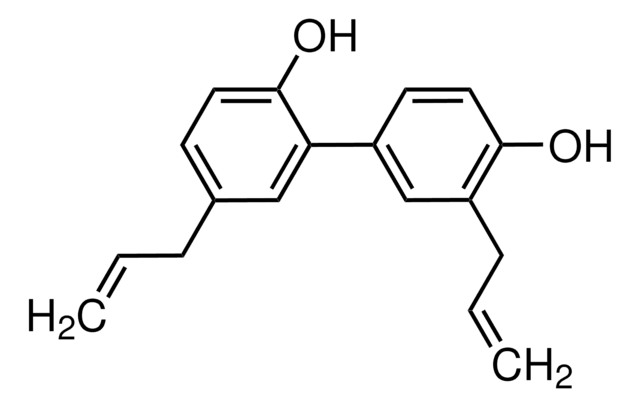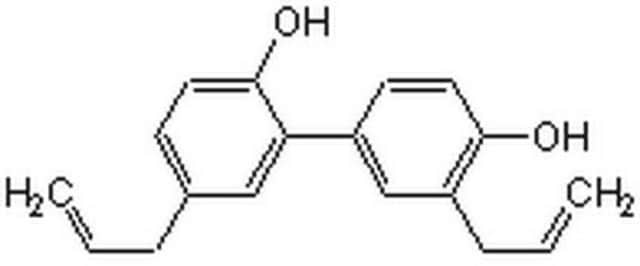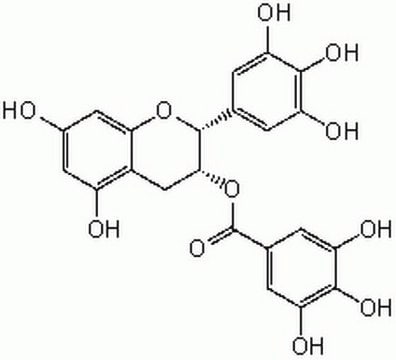H4914
Honokiol
≥98% (HPLC), powder
Synonym(s):
5,3′-Diallyl-2,4′-dihydroxybiphenyl, NSC 293100
About This Item
Recommended Products
Assay
≥98% (HPLC)
form
powder
storage condition
desiccated
solubility
DMSO: 36 mg/mL
antibiotic activity spectrum
Gram-positive bacteria
neoplastics
Mode of action
DNA synthesis | interferes
storage temp.
2-8°C
SMILES string
Oc1ccc(cc1CC=C)-c2cc(CC=C)ccc2O
InChI
1S/C18H18O2/c1-3-5-13-7-9-18(20)16(11-13)14-8-10-17(19)15(12-14)6-4-2/h3-4,7-12,19-20H,1-2,5-6H2
InChI key
FVYXIJYOAGAUQK-UHFFFAOYSA-N
Looking for similar products? Visit Product Comparison Guide
General description
Application
- to study its effects on plasmid hSirt3102-399 deacetylation activity
- as an antioxidant to study its cytoprotective role in human ovarian cancer cells (SKOV-3) and Chinese hamster ovary cells (CHOK1)
- to explore its effects on oxidative stress and mitochondrial dysfunction via a sirt3-dependent manner
- for intracerebroventricular (ICV) cannulation
Biochem/physiol Actions
Features and Benefits
Signal Word
Danger
Hazard Statements
Precautionary Statements
Hazard Classifications
Aquatic Chronic 2 - Eye Dam. 1
Storage Class Code
11 - Combustible Solids
WGK
WGK 3
Flash Point(F)
Not applicable
Flash Point(C)
Not applicable
Personal Protective Equipment
Certificates of Analysis (COA)
Search for Certificates of Analysis (COA) by entering the products Lot/Batch Number. Lot and Batch Numbers can be found on a product’s label following the words ‘Lot’ or ‘Batch’.
Already Own This Product?
Find documentation for the products that you have recently purchased in the Document Library.
Customers Also Viewed
Articles
Chronic inflammation is an underlying factor in the development and progression of many of the chronic diseases of aging, such as arthritis, atherosclerosis, diabetes, and cancer.
Cell cycle phases (G1, S, G2, M) regulate cell growth, DNA replication, and division in proliferating cells.
Cell cycle phases (G1, S, G2, M) regulate cell growth, DNA replication, and division in proliferating cells.
Cell cycle phases (G1, S, G2, M) regulate cell growth, DNA replication, and division in proliferating cells.
Our team of scientists has experience in all areas of research including Life Science, Material Science, Chemical Synthesis, Chromatography, Analytical and many others.
Contact Technical Service
















